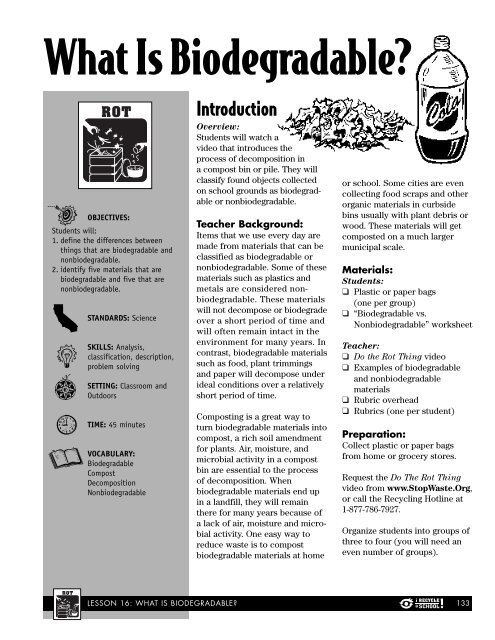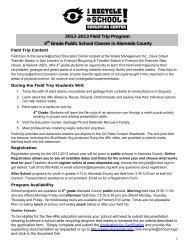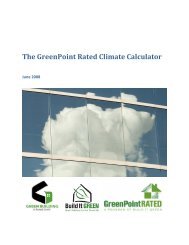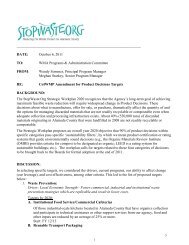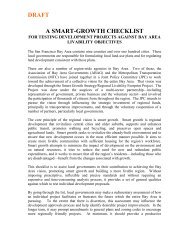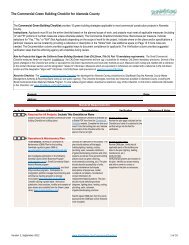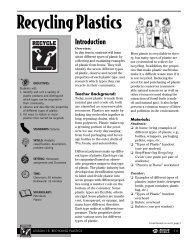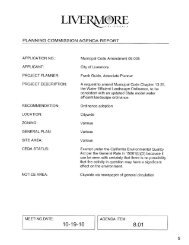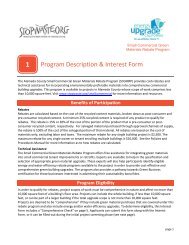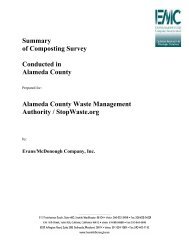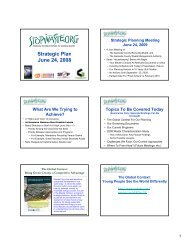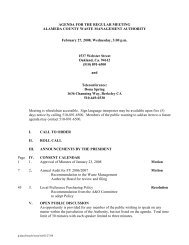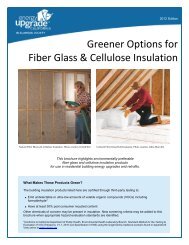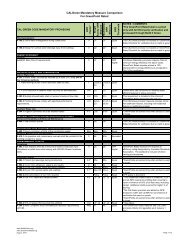What Is Biodegradable? - StopWaste.org
What Is Biodegradable? - StopWaste.org
What Is Biodegradable? - StopWaste.org
You also want an ePaper? Increase the reach of your titles
YUMPU automatically turns print PDFs into web optimized ePapers that Google loves.
<strong>What</strong> <strong>Is</strong> <strong>Biodegradable</strong>?<br />
v<br />
T<br />
T<br />
u<br />
P<br />
A<br />
OBJECTIVES:<br />
Students will:<br />
1. define the differences between<br />
things that are biodegradable and<br />
nonbiodegradable.<br />
2. identify five materials that are<br />
biodegradable and five that are<br />
nonbiodegradable.<br />
STANDARDS: Science<br />
SKILLS: Analysis,<br />
classification, description,<br />
problem solving<br />
SETTING: Classroom and<br />
Outdoors<br />
TIME: 45 minutes<br />
VOCABULARY:<br />
<strong>Biodegradable</strong><br />
Compost<br />
Decomposition<br />
Nonbiodegradable<br />
Introduction<br />
Overview:<br />
Students will watch a<br />
video that introduces the<br />
process of decomposition in<br />
a compost bin or pile. They will<br />
classify found objects collected<br />
on school grounds as biodegradable<br />
or nonbiodegradable.<br />
Teacher Background:<br />
Items that we use every day are<br />
made from materials that can be<br />
classified as biodegradable or<br />
nonbiodegradable. Some of these<br />
materials such as plastics and<br />
metals are considered nonbiodegradable.<br />
These materials<br />
will not decompose or biodegrade<br />
over a short period of time and<br />
will often remain intact in the<br />
environment for many years. In<br />
contrast, biodegradable materials<br />
such as food, plant trimmings<br />
and paper will decompose under<br />
ideal conditions over a relatively<br />
short period of time.<br />
Composting is a great way to<br />
turn biodegradable materials into<br />
compost, a rich soil amendment<br />
for plants. Air, moisture, and<br />
microbial activity in a compost<br />
bin are essential to the process<br />
of decomposition. When<br />
biodegradable materials end up<br />
in a landfill, they will remain<br />
there for many years because of<br />
a lack of air, moisture and microbial<br />
activity. One easy way to<br />
reduce waste is to compost<br />
biodegradable materials at home<br />
or school. Some cities are even<br />
collecting food scraps and other<br />
<strong>org</strong>anic materials in curbside<br />
bins usually with plant debris or<br />
wood. These materials will get<br />
composted on a much larger<br />
municipal scale.<br />
Materials:<br />
Students:<br />
❑ Plastic or paper bags<br />
(one per group)<br />
❑ “<strong>Biodegradable</strong> vs.<br />
Nonbiodegradable” worksheet<br />
Teacher:<br />
❑ Do the Rot Thing video<br />
❑ Examples of biodegradable<br />
and nonbiodegradable<br />
materials<br />
❑ Rubric overhead<br />
❑ Rubrics (one per student)<br />
Preparation:<br />
Collect plastic or paper bags<br />
from home or grocery stores.<br />
Request the Do The Rot Thing<br />
video from www.<strong>StopWaste</strong>.Org,<br />
or call the Recycling Hotline at<br />
1-877-786-7927.<br />
Organize students into groups of<br />
three to four (you will need an<br />
even number of groups).<br />
LESSON 16: WHAT IS BIODEGRADABLE? 133
ACTIVITY<br />
Discussion<br />
1. Ask students to name items that get thrown away at<br />
school and at home. Record their suggestions on the<br />
board. Explain that some of the items listed on the board<br />
are biodegradable (circle these items) such as notebook<br />
paper, leaves and food scraps, which means they can<br />
easily decay.<br />
2. Pass around some examples of biodegradable items. Ask<br />
students whether they can share some examples of items<br />
that may not decompose or decay over time. Have students<br />
point out nonbiodegradable items on the board and<br />
underline them. Pass around some examples of<br />
nonbiodegradable items.<br />
3 Ask students whether they use more biodegradable or<br />
more nonbiodegradable materials.<br />
4. Have students share their ideas on how to recycle<br />
biodegradable materials. Explain that these materials can<br />
be recycled through composting.<br />
5. Tell the students that they will learn about biodegradable<br />
materials by watching a video of things decomposing over<br />
time in a compost bin and collecting examples of<br />
biodegradable and nonbiodegradable materials outside.<br />
6. Show an overhead of the lesson rubric, and review the<br />
expectations for this lesson.<br />
Procedure<br />
1. Show the video Do the Rot Thing. Prepare the<br />
students to watch the video by assigning them to<br />
look for the differences between biodegradable<br />
and nonbiodegradable materials.<br />
2. Lead students in a discussion about the video that will<br />
provide examples of the differences between biodegradable<br />
and nonbiodegradable. Review and define the concepts<br />
presented in the video.<br />
3. Organize students into small groups. Assign half of the<br />
groups to take bags outdoors and collect items that they<br />
think are biodegradable, e.g., leaves, twigs, food scraps,<br />
etc. The other half will collect items that they think are<br />
nonbiodegradable, e.g., metals, plastics, rocks.<br />
4. Pair up small groups (one biodegradable and one<br />
nonbiodegradable), and ask the groups to switch bags<br />
and examine the examples collected by the other<br />
group. For example, students in a group that collected<br />
nonbiodegradable items will examine biodegradable items<br />
collected by another group.<br />
5. In groups, students will classify the items as biodegradable<br />
(<strong>org</strong>anic materials from once living <strong>org</strong>anisms) and<br />
nonbiodegradable (usually from nonliving origins, such as<br />
metal, rock, etc.). Some items may be moved from one<br />
collection into another if there is a group consensus.<br />
6. As a class, discuss examples in each group that were<br />
difficult to classify.<br />
7. Ask students how they could test objects to find out<br />
whether they are biodegradable. <strong>What</strong> evidence would<br />
they expect to observe that would indicate that the<br />
object is biodegradable? For example, what conditions are<br />
necessary for things to decompose (air, water, heat, etc.)?<br />
8. Assign students to write a list of at least five items<br />
that are biodegradable and five items that are<br />
nonbiodegradable.<br />
Wrap-Up<br />
1. Have students compare and contrast the materials shown<br />
in the video to the materials collected outside. Discuss<br />
similarities and differences.<br />
2. Ask the students whether they think they can find<br />
materials that are biodegradable at home. Discuss ways<br />
to recycle these materials such as starting a compost bin.<br />
Final Assessment Idea<br />
Have students write a description of the differences<br />
between items that are biodegradable versus those that<br />
are nonbiodegradable in their own words.<br />
134 LESSON 16: WHAT IS BIODEGRADABLE?
RESOURCES<br />
Extensions:<br />
Using the Internet, have students research how long it takes biodegradable waste items to decompose<br />
if placed in a landfill.<br />
Teacher Materials:<br />
California State Content Standards<br />
The standards below represent broad academic concepts. This lesson provides connections to these<br />
academic concepts through hands-on activities and exploration. This lesson is not designed for a student<br />
to master the concepts presented in the standards. Additional lessons in the classroom that build on this<br />
lesson or the standard(s) ensure that students will have the opportunity to master these concepts.<br />
SCIENCE CONTENT STANDARDS<br />
Grade 4 Life Science<br />
2.a. Students know plants are the primary source of matter and<br />
energy entering most food chains.<br />
2.c. Students know decomposers, including many fungi, insects, and<br />
micro-<strong>org</strong>anisms, recycle matter from dead plants and animals.<br />
3.a. Students know ecosystems can be characterized by their living<br />
and nonliving components.<br />
Grade 5 Investigation and Experimentation<br />
6.a. Students will classify objects (e.g., rocks, plants, leaves) in<br />
accordance with the appropriate criteria.<br />
LESSON 16: WHAT IS BIODEGRADABLE? 135
Teacher<br />
<strong>What</strong> is <strong>Biodegradable</strong>? Rubric<br />
A rubric is a scoring tool that defines the criteria by which a student’s work will be evaluated.<br />
This rubric is provided to assist you in setting expectations for students and assessing their performance<br />
and engagement during the lesson based on specific tasks. Ideally, a rubric is developed with the cooperation<br />
of the students. Two blank rows have been provided for you and your class to develop and add<br />
your own assessment criteria.<br />
CATEGORY 4 3 2 1<br />
Identifies<br />
biodegradable<br />
items<br />
Identifies<br />
nonbiodegradable<br />
items<br />
Describes the<br />
differences<br />
between<br />
biodegradable<br />
and nonbiodegradable<br />
items<br />
Student identifies<br />
five or more<br />
biodegradable<br />
items.<br />
Student identifies<br />
five or more<br />
nonbiodegradable<br />
items.<br />
Student clearly<br />
describes the differences<br />
between<br />
biodegradable and<br />
nonbiodegradable<br />
items.<br />
Student identifies<br />
four biodegradable<br />
items.<br />
Student identifies<br />
four nonbiodegradable<br />
items.<br />
Student describes<br />
some differences<br />
between<br />
biodegradable<br />
and nonbiodegradable<br />
items.<br />
Student identifies<br />
two to three<br />
biodegradable<br />
items.<br />
Student identifies<br />
two to three nonbiodegradable<br />
items.<br />
Student has difficulty<br />
describing<br />
differences<br />
between biodegradable<br />
and<br />
nonbiodegradable<br />
items.<br />
Student fails<br />
to do the<br />
assignment.<br />
Student fails<br />
to do the<br />
assignment.<br />
Student fails<br />
to do the<br />
assignment.<br />
136 LESSON 16: WHAT IS BIODEGRADABLE?
BIODEGRADABLE NONBIODEGRADABLE<br />
1. 1.<br />
Name: Date:<br />
Student<br />
<strong>Biodegradable</strong> vs. Nonbiodegradable<br />
Directions: List the items that are biodegradable and nonbiodegradable.<br />
2. 2.<br />
3. 3.<br />
4. 4.<br />
5. 5.<br />
1. Describe the differences between things that are biodegradable and nonbiodegradable.<br />
2. Describe what would happen to a biodegradable item from your list if it began to decompose.<br />
LESSON 16: WHAT IS BIODEGRADABLE? 137
DEFINITIONS<br />
Vocabulary:<br />
<strong>Biodegradable</strong>: <strong>org</strong>anic<br />
materials that can decompose<br />
or decay, such as wood,<br />
food scraps, paper and grass<br />
clippings.<br />
Compost: the process or the<br />
end result of living <strong>org</strong>anisms<br />
digesting and reducing <strong>org</strong>anic<br />
material into a dark, rich, soil<br />
amendment.<br />
Decomposition: the process<br />
of materials being digested<br />
and broken down into simpler<br />
substances, making nutrients<br />
more available to plants.<br />
Decomposition happens all the<br />
time in nature and in humanmanaged<br />
systems such as<br />
compost bins.<br />
Nonbiodegradable: in<strong>org</strong>anic<br />
materials that do not decompose,<br />
for example, glass, metal<br />
and plastic.<br />
138 LESSON 16: WHAT IS BIODEGRADABLE?
BIODEGRADABLE NO-BIODEGRADABLE<br />
1. 1.<br />
Estudiante<br />
<strong>Biodegradable</strong> vs. No <strong>Biodegradable</strong><br />
Instrucciones: Enumere los artículos que son biodegradables y no biodegradables.<br />
2. 2.<br />
3. 3.<br />
4. 4.<br />
5. 5.<br />
1. Describa las diferencias entre las cosas que son biodegradables y no biodegradables.<br />
2. Describa que le pasaría a los artículos biodegradables que están en su lista si se empiezan a descomponer.<br />
Nombre: Fecha:<br />
LECCIÓN 16: ¿QUE ES BIODEGRADABLE? 137
DEFINICIONES<br />
Vocabulario:<br />
Abono: El proceso ó resultado<br />
final de <strong>org</strong>anismos vivos que<br />
digieren y reducen materiales<br />
<strong>org</strong>ánicos y los convierten en un<br />
aditivo de tierra rica.<br />
<strong>Biodegradable</strong>: Materiales<br />
<strong>org</strong>ánicos que se descomponen<br />
o se pudren como la madera,<br />
sobras de comida, papel y<br />
recortes de pasto.Jergón:<br />
Material como hojas secas o<br />
papel triturado utilizado para<br />
retener húmedad, crear espacios<br />
de aire y cubrir las sobras de<br />
comida en un sistema de abono<br />
de lombrices.<br />
Descomposición: El proceso<br />
de materiales que son digeridos<br />
y transformados a sustancias<br />
simples, haciendo las sustancias<br />
nutritivas más disponibles a las<br />
plantas. La descomposición<br />
occurre todo el tiempo en la naturaleza<br />
y en los sistemas controlados<br />
por seres humanos como<br />
por ejemplo el recipiente de<br />
abono.<br />
No biodegradable: Materiales<br />
in<strong>org</strong>ánicos que no se<br />
pudren(desconponen) por ejemplo,<br />
vidrio, metal y plástico.<br />
138 LECCIÓN 16: ¿QUE ES BIODEGRADABLE?


